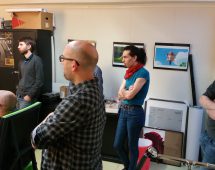
Blender Institute had 3 days of coder/artist workshops on 2.8 designs and targets. Having 12 brains going over all aspects of usability and technical concepts has been extremely useful. The team is gathering all notes and designs currently and will make extensive reports for everyone here soon. Some docs will appear on the code.blender.org site, most of them go to wiki.blender.org.
I can happily confirm that we agreed on everything we’ll present. It’s well aligned with what we started for 2.5, very good to have clear focus and direction! Of course we look forward to a public review and high level of support by everyone who’s involved with Blender.
While the real detailed docs are getting reviewed and finalized, I’d like to share the highlights with you in this short summary:
Blender 2.5 concepts
- Design principles of original 2.5 doc were verified and confirmed to be valid still.
- Suggested is to make more use of temporary popups for settings (viewport settings, etc). That clears up the too long property panel lists.
- The select-tool order can be kept working by use of new toolbar that will present tools using new widget/manipulators. Goal will be that most operators will get the ‘redo’ operator as widgets in an editor, allowing users to tweak operations more efficient, but also to repeat it on a different selection. For example translate and rotate, but also spin, duplicate, extrude, knife, etc can work this way.
Layers
- The Scene Object list will become a hierarchical list of Object Collections. Each Collection can hold other Collections and hold all the Objects you want. Objects can be in multiple Collections.
- The new Layers then use (= point to) the Scene Collections to define what’s visible, or editable, or edit overrides (draw types, materials, etc). This way you can set up Layers that use the same Collections, but with different visibility and render settings.
- Those Layers will be used by all editors (including viewports) and render engines and the compositor.
- Visualization of Object-mode and Edit-modes in Blender will be coded as a special drawing engine, composited on top of viewport drawing/rendering itself.
- New configuration files will allow to define “Workspaces”, which will be available as tabs in the top header of a window. Each Workspace can store multiple layouts (old name ‘Screen’), and will allow to filter or change visible panels, tools, menus, active addons and shortcuts.
- Blender’s screens (layouts) will get a default top bar for menus, for active scene, for active mode and for active layer. Scene, Mode and active Layer will be ‘global’ for all editors in that workspace.
- Further workflow configuration will be enabled by efficient use of template files (sets of default assets or primitives) and a project file (settings that need to be set per project, such as file paths or web settings).
- Special attention will go to deliver a couple of low-level input “keymaps” for input devices like mouse, pens, tablets and touchpads. These should be selected based on your hardware setup and preferences (left select, right select). On top of that we make 1 strong (more minimal) default shortcut keymap for all basic operations.
Technical design
- Each Layer gets own dependency graph
- Overrides can be static (on start/load) or dynamic (animated).
- Overrides in two types: to replace values (color, etc), or add/remove items from a list (modifiers, constraints, etc).
- Particles and hair systems will be put back, but as own primitive type. Full proposal coming soon.
Participants were a very diverse group of coders and artist/contributors:
Pablo Vazquez, Julian Eisel, Paweł Łyczkowski, Daniel Lara, Sebastian Koenig, Bastien Montagne, Brecht van Lommel, Mike Pan, Sergey Sharybin, Dalai Felinto, Ton Roosendaal and Jonathan Williamson remotely.
Ton Roosendaal
1 December 2016

